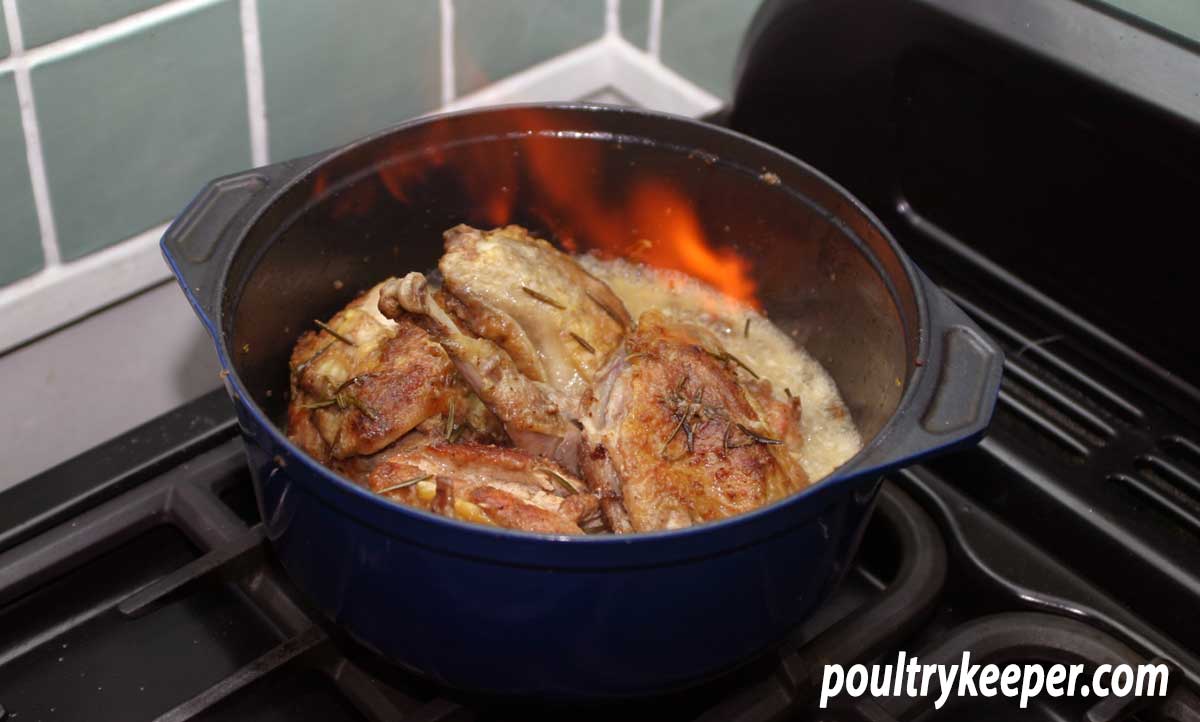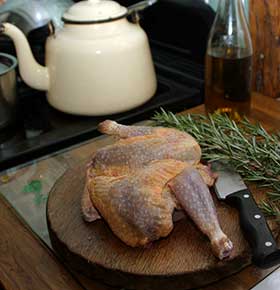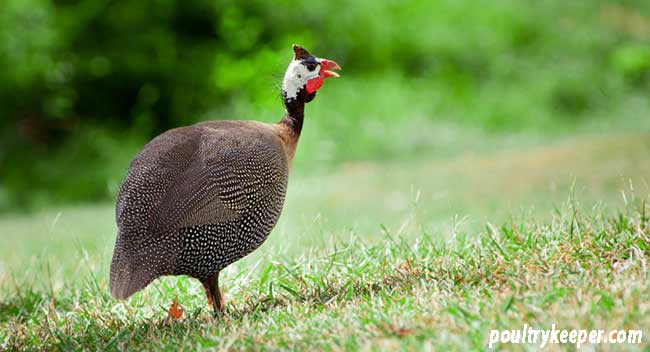
Poultry
Recipes

Feeds: 4 people
Preparation Time: 15 minutes
Cooking Time: 45 minutes
Guinea fowl with garlic and rosemary is one of my favourite recipes. It isn’t difficult to prepare or cook, and if you have children, they will love seeing you flambé the dish! Guinea fowl makes a great alternative to chicken and, in my opinion, is drastically under-rated in the UK and well worth seeking out.
Related to the chicken and partridge, Guinea fowl has a slightly gamey taste, but this is very subtle and not as strong as pheasant. Garlic and rosemary work extremely well with this flavoursome meat which is also low in cholesterol, high in protein and a great source of vitamin B6, niacin and selenium.
You will often see rows of Guinea fowl on the fridge shelves of French supermarkets; I even saw a recipe leaflet for Guinea fowl with garlic and rosemary in one supermarket, a traditional French dish. You can still find Guinea fowl for sale in the larger supermarkets in the UK, but there aren’t usually very many.
If you fancy rearing your own Guinea’s, they are relatively easy to keep on a smallholding (there’s more on keeping Guinea fowl here).
I find them one of the easiest birds to pluck and prepare.

Guinea fowl are very useful. They are observant watchdogs and mop up many insects and bugs around the garden, although their noisy chatter isn’t appreciated by near neighbours.
Guinea fowl tastes wonderful when it is simply roast, much the same as chicken but do keep in mind it is a smaller bird, and care should be taken so that it doesn’t get overcooked.
Regular basting is recommended so that the meat doesn’t dry out.
I prefer cooking my Guinea fowl with garlic and rosemary in a heavy cast iron pan. The robust flavours really compliment the slightly gamey taste of the bird.
Ingredients
Here are the ingredients you will need.
1 Guinea fowl
Plain flour
3 Cloves of garlic
A good sprig of rosemary
Some olive oil
A glass of white wine
Salt and pepper (freshly ground is best!)
Preparation of your Guinea fowl
Cut the guinea fowl into quarters and season with salt and pepper. Rub plain flour over the pieces. Add a good glug of Olive Oil to a large, heavy casserole or frying pan and heat.
Click on the images to enlarge them.
Cooking Guinea fowl with garlic and rosemary
When it is hot, add the guinea fowl pieces and sear all sides until it is golden, almost crispy. Slice the garlic and tear the rosemary leaves. Add these to the pan, reduce the heat, cover and cook for 30 minutes, and occasionally turn.
After 30 minutes, turn the heat back up and when the pan is hot again, add the white wine and flambé. If you can’t get the wine to light, don’t worry; just allow enough time for the alcohol to evaporate. It should light, though, if the pan is hot enough.
Leave the wine to evaporate for 2 minutes. The guinea fowl is now ready to be served! It will keep hot for a short while with the lid on whilst you serve the vegetables.
We normally serve with whatever vegetables we have in the garden or are in season and drizzle the sauce over the meat and vegetables once served. If you use quite a lot of rosemary like me then you may want to put the sauce through a sieve beforehand otherwise you can end up with a little too much rosemary on your plate.
I hope you enjoy it!




